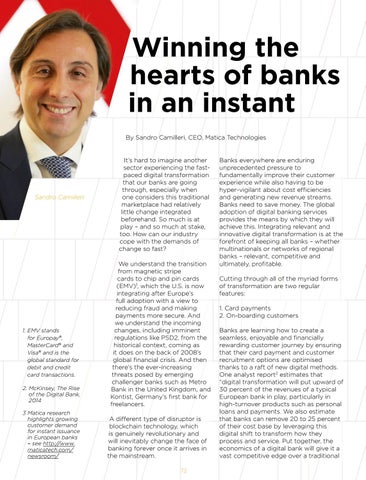Winning the hearts of banks in an instant By Sandro Camilleri, CEO, Matica Technologies
Sandro Camilleri
1. E MV stands for Europay®, MasterCard® and Visa® and is the global standard for debit and credit card transactions. 2. M cKinsey, The Rise of the Digital Bank, 2014 3M atica research highlights growing customer demand for instant issuance in European banks – see http://www. maticatech.com/ newsroom/
It’s hard to imagine another sector experiencing the fastpaced digital transformation that our banks are going through, especially when one considers this traditional marketplace had relatively little change integrated beforehand. So much is at play – and so much at stake, too. How can our industry cope with the demands of change so fast? We understand the transition from magnetic stripe cards to chip and pin cards (EMV)1, which the U.S. is now integrating after Europe’s full adoption with a view to reducing fraud and making payments more secure. And we understand the incoming changes, including imminent regulations like PSD2, from the historical context, coming as it does on the back of 2008’s global financial crisis. And then there’s the ever-increasing threats posed by emerging challenger banks such as Metro Bank in the United Kingdom, and Kontist, Germany’s first bank for freelancers. A different type of disruptor is blockchain technology, which is genuinely revolutionary and will inevitably change the face of banking forever once it arrives in the mainstream. 72
Banks everywhere are enduring unprecedented pressure to fundamentally improve their customer experience while also having to be hyper-vigilant about cost efficiencies and generating new revenue streams. Banks need to save money. The global adoption of digital banking services provides the means by which they will achieve this. Integrating relevant and innovative digital transformation is at the forefront of keeping all banks – whether multinationals or networks of regional banks – relevant, competitive and ultimately, profitable. Cutting through all of the myriad forms of transformation are two regular features: 1. Card payments 2. On-boarding customers Banks are learning how to create a seamless, enjoyable and financially rewarding customer journey by ensuring that their card payment and customer recruitment options are optimised thanks to a raft of new digital methods. One analyst report2 estimates that “digital transformation will put upward of 30 percent of the revenues of a typical European bank in play, particularly in high-turnover products such as personal loans and payments. We also estimate that banks can remove 20 to 25 percent of their cost base by leveraging this digital shift to transform how they process and service. Put together, the economics of a digital bank will give it a vast competitive edge over a traditional

